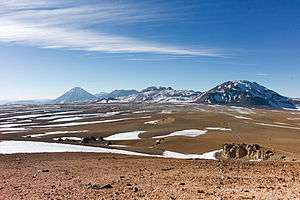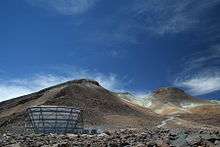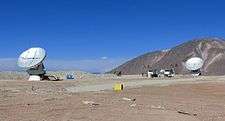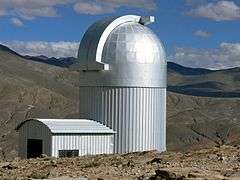
View showing several of the world's highest observatory sites in Chile, looking north across the Llano de Chajnantor and ALMA site, with the peaks of Cerro Toco (right center) and Cerro Chajnantor (right) rising above.

Particle detector at Chacaltaya Astrophysical Observatory, the highest permanent astronomical observatory in the world from the 1940s through 2009.

Atacama Cosmology Telescope on Cerro Toco, just north of the Llano de Chajnantor.

View looking northeast across the Llano de Chajnantor and the first two ALMA antennas in late 2009, with Cerro Chajnantor rising above at right.

The Indian Astronomical Observatory stands at an altitude of 4,500 m (14,800 ft) on Mount Saraswati in Ladakh, India.

Aerial view of part of the Mauna Kea Observatory, showing Subaru, Keck, and IRTF telescopes (left to right).
This is a list of the highest astronomical observatories in the world, considering only ground-based observatories and ordered by elevation above mean sea level. The main list includes only permanent observatories with facilities constructed at a fixed location, followed by a supplementary list for temporary observatories such as transportable telescopes or instrument packages. For large observatories with numerous telescopes at a single location, only a single entry is included listing the main elevation of the observatory or of the highest operational instrument if that information is available.
History of high altitude astronomical observatories
Prior to the late 19th century, almost all astronomical observatories throughout history were located at modest elevations, often close to cities and educational institutions for the simple reason of convenience.[1] As air pollution from industrialization and light pollution from artificial lighting increased during the Industrial Revolution, astronomers sought observatory sites in remote locations with clear and dark skies, naturally drawing them towards the mountains. The first permanent mountaintop astronomical observatory was the Lick Observatory constructed from 1876 to 1887, at the modest elevation of 1,283 m (4,209 ft) atop Mount Hamilton in California.[2] The first high altitude observatory was constructed atop the 2,877 m (9,439 ft) Pic du Midi de Bigorre in the French Pyrenees starting in 1878, with its first telescope and dome installed in 1904.[3] Astronomical observations were also made from Mont Blanc in the late 1800s.[4]
A few other high altitude observatories (such as the Lowell Observatory in Arizona and Sphinx Observatory in Switzerland) were constructed through the first half of the 20th century. However, the two most important and prominent of the early 20th century observatories, Mount Wilson Observatory and Palomar Observatory, were both located on mid-elevation mountaintops of about 1,700 m (5,600 ft) in southern California.[5] The stunning successes and discoveries made there using the world's largest telescopes, the 100-inch Hooker Telescope and 200-inch Hale Telescope, spurred the move to ever higher sites for the new generation of observatories and telescopes after World War II, along with a worldwide search for locations which had the best astronomical seeing.
Since the mid-20th century, an increasing number of high altitude observatory sites have been developed at locations around the world, including numerous sites in Arizona, Hawaii, Chile, and the Canary Islands.[6][7] The initial wave of high-altitude sites were mostly in the 2,000–2,500 m (6,600–8,200 ft) range, but astronomers soon sought even higher sites above 3,000 m (9,800 ft). Among the largest, best developed, and most renowned of these high altitude sites is the Mauna Kea Observatory located near the summit of a 4,205 m (13,796 ft) volcano in Hawaii, which has grown to include over a dozen major telescopes during the four decades since it was founded. In the first decade of the 21st century, there has been a new wave of observatory construction at very high altitudes above 4,500 m (14,800 ft), with such observatories constructed in India, Mexico, and most notably the Atacama Desert in northern Chile, now the site of several of the world's highest observatories. The scientific benefits of these sites outweigh the numerous logistical and physiological challenges which must be overcome during the construction and operation of observatories in remote mountain locations, even in desert, polar, and tropical island sites which magnify the challenges but confer additional observational advantages.
Sites at high altitude are ideal for optical astronomy and provide optimal seeing, being above a significant portion of the Earth's atmosphere with its associated weather, turbulence, and diminished clarity. In particular, sites on mountaintops within about 80 km (50 mi) of the ocean often have excellent observing conditions above a stable inversion layer throughout much of the year.[8] High altitude sites are also above most of atmosphere's water vapor, making them ideal for infrared astronomy and submillimeter astronomy as those wavelengths are strongly absorbed by water vapor. On the other hand, high altitude does not offer as significant an advantage for radio astronomy at longer wavelengths, so relatively few radio telescopes are located at such sites. At the far end of the spectrum, for the extremely short wavelengths of x-ray and gamma ray astronomy, along with high-energy cosmic rays, high altitude observations once again offers significant advantages, enough that many experiments at these wavelengths have been conducted by balloon-borne or even by space telescopes, although a number of high-altitude ground-based sites have also been used. These include the Chacaltaya Astrophysical Observatory in Bolivia, which at 5,230 m (17,160 ft) was the world's highest permanent astronomical observatory[9] from the time of its construction during the 1940s until surpassed in 2009 by the new University of Tokyo Atacama Observatory,[10] an optical-infrared telescope on a remote 5,640 m (18,500 ft) mountaintop in Chile.
Highest permanent observatories
Permanent observatories above 3,000 m:
| Observatory Name |
Elevation |
Observatory Site |
Location |
Coordinates |
Established |
Type of Observatory |
Major Instruments |
| University of Tokyo Atacama Observatory (TAO) |
5,640 m (18,500 ft)[10] |
Cerro Chajnantor |
Atacama Desert, Chile |
22°59′12″S 67°44′32″W / 22.98667°S 67.74222°W / -22.98667; -67.74222 |
2009[10] |
Optical, infrared |
|
| Chacaltaya Astrophysical Observatory |
5,230 m (17,160 ft)[9] |
Chacaltaya |
Andes, Bolivia |
16°21′12″S 68°07′53″W / 16.35333°S 68.13139°W / -16.35333; -68.13139 |
1946[9] |
Cosmic ray, gamma ray |
|
| James Ax Observatory |
5,200 m (17,100 ft) |
Cerro Toco |
Atacama Desert, Chile |
22°57′30″S 67°47′10″W / 22.95833°S 67.78611°W / -22.95833; -67.78611 |
2011 |
Microwave |
POLARBEAR |
| Atacama Cosmology Telescope |
5,190 m (17,030 ft) |
Cerro Toco |
Atacama Desert, Chile |
22°57′31″S 67°47′16″W / 22.95861°S 67.78778°W / -22.95861; -67.78778 |
2007 |
Microwave |
|
| Llano de Chajnantor Observatory |
5,104 m (16,745 ft) |
Llano de Chajnantor |
Atacama Desert, Chile |
23°01′22″S 67°45′17″W / 23.02278°S 67.75472°W / -23.02278; -67.75472 |
1999 |
Millimeter wave, submillimeter |
ALMA, APEX, QUIET |
Shiquanhe Observatory
(NAOC Ali Observatory)[11] |
5,100 m (16,700 ft)[12] |
Shiquanhe, Ngari Plateau |
Tibet Autonomous Region, China |
32°19′N 80°01′E / 32.317°N 80.017°E / 32.317; 80.017 |
2011 |
Optical |
| Large Latin American Millimeter Array (LLAMA) |
4,825 m (15,830 ft) |
Alto de Chorillos |
Salta, Argentina |
24°11′31″S 66°28′29″W / 24.19194°S 66.47472°W / -24.19194; -66.47472 |
Under Construction |
Submillimeter |
LLAMA |
| Llano de Chajnantor Observatory |
4,800 m (15,700 ft) |
Pampa La Bola |
Atacama Desert, Chile |
22°58′17″S 67°42′10″W / 22.97139°S 67.70278°W / -22.97139; -67.70278 |
2002 |
Submillimeter |
ASTE, NANTEN2 |
| Large Millimeter Telescope Alfonso Serrano |
4,580 m (15,030 ft) |
Sierra Negra |
Puebla, Mexico |
18°59′06″N 97°18′53″W / 18.98500°N 97.31472°W / 18.98500; -97.31472 |
2006 |
Microwave |
|
| Indian Astronomical Observatory |
4,500 m (14,800 ft) |
Mount Saraswati[13] |
Hanle, Ladakh, India |
32°46′46″N 78°57′51″E / 32.77944°N 78.96417°E / 32.77944; 78.96417 |
2001 |
Infrared, gamma ray, Optical[14] |
Himalayan Chandra Telescope, HAGAR |
| Meyer-Womble Observatory |
4,312 m (14,147 ft) |
Mount Evans |
Colorado, United States |
39°35′12″N 105°38′24″W / 39.58667°N 105.64000°W / 39.58667; -105.64000 |
1996 |
Optical, Infrared |
|
| Yangbajing International Cosmic Ray Observatory |
4,300 m (14,100 ft)[15] |
Yangbajain |
Tibet Autonomous Region, China |
30°05′N 90°33′E / 30.083°N 90.550°E / 30.083; 90.550 |
1990[16] |
Cosmic ray |
|
| Mauna Kea Observatory |
4,190 m (13,750 ft)[17] |
Mauna Kea |
Hawaii, United States |
19°49′28″N 155°28′24″W / 19.82444°N 155.47333°W / 19.82444; -155.47333 |
1967 |
Optical, infrared, submillimeter |
Keck, UKIRT, Gemini North, Subaru, JCMT, CSO, SMA, CFHT |
| High Altitude Water Cherenkov (HAWC) Gamma-Ray Observatory |
4,100 m (13,500 ft) |
Sierra Negra |
Puebla, Mexico |
18°59′40″N 97°18′33″W / 18.99444°N 97.30917°W / 18.99444; -97.30917 |
2013 |
Gamma ray |
|
| Barcroft Observatory[18] |
3,890 m (12,760 ft)[19] |
White Mountain Peak |
California, United States |
37°35′19″N 118°14′31″W / 37.58861°N 118.24194°W / 37.58861; -118.24194 |
1976 |
Infrared, millimeter wave |
|
| Very Long Baseline Array (VLBA), Mauna Kea Site |
3,730 m (12,240 ft)[20] |
Mauna Kea |
Hawaii, United States |
19°48′05″N 155°27′20″W / 19.80139°N 155.45556°W / 19.80139; -155.45556 |
1986 |
Radio telescope |
|
| Llano del Hato National Astronomical Observatory |
3,600 m (11,800 ft) |
Llano del Hato |
Andes, Venezuela |
8°47′11″N 70°52′19″W / 8.78639°N 70.87194°W / 8.78639; -70.87194 |
1970s |
Optical telescope |
|
| Sphinx Observatory |
3,571 m (11,716 ft) |
Jungfraujoch |
Bernese Alps, Switzerland |
46°32′51″N 7°59′6″E / 46.54750°N 7.98500°E / 46.54750; 7.98500 |
1937 |
Optical telescope |
|
| Mauna Loa Observatory |
3,394 m (11,135 ft) |
Mauna Loa |
Hawaii, United States |
19°32′10″N 155°34′34″W / 19.53611°N 155.57611°W / 19.53611; -155.57611 |
1957 |
Optical, millimeter wave |
Mauna Loa Solar Observatory, AMiBA |
| Magdalena Ridge Observatory |
3,230 m (10,600 ft) |
South Baldy |
New Mexico, United States |
33°58′36″N 107°11′05″W / 33.97667°N 107.18472°W / 33.97667; -107.18472 |
1999 |
Optical, infrared |
|
| Mount Graham International Observatory |
3,191 m (10,469 ft) |
Mount Graham |
Arizona, United States |
32°42′05″N 109°53′31″W / 32.70139°N 109.89194°W / 32.70139; -109.89194 |
1993 |
Optical, submillimeter |
LBT, HHST, VATT |
| Gornergrat Observatory |
3,135 m (10,285 ft) |
Gornergrat |
Pennine Alps, Switzerland |
45°59′04″N 7°47′09″E / 45.98444°N 7.78583°E / 45.98444; 7.78583 |
1967 |
Infrared, submillimeter |
Gornergrat Infrared Telescope, KOSMA |
| European Extremely Large Telescope |
3,060 m (10,040 ft) |
Cerro Armazones |
Atacama Desert, Chile |
24°35′20″S 70°11′32″W / 24.58889°S 70.19222°W / -24.58889; -70.19222 |
Not completed |
Optical, near infrared |
|
| Haleakala Observatory |
3,036 m (9,961 ft)[21] |
Haleakala |
Hawaii, United States |
20°42′30″N 156°15′27″W / 20.70833°N 156.25750°W / 20.70833; -156.25750 |
1964 |
Optical, millimeter wave |
Pan-STARRS, LCOGTFaulkes Telescope North, AEOS |
Highest temporary observatories
Temporary observatories above 3,000 m:
| Observatory Name |
Elevation |
Observatory Site |
Location |
Coordinates |
Established |
Type of Observatory |
Major Instruments |
| Receiver Lab Telescope[22] |
5,525 m (18,127 ft) |
Cerro Sairecabur |
Atacama Desert, Chile |
22°43′0″S 67°53′30″W / 22.71667°S 67.89167°W / -22.71667; -67.89167 |
2002 |
Submillimeter, 1-2 THz[23] |
|
| PLATO (PLATeau Observatory) [24] |
4,091 m (13,422 ft) |
Dome A |
East Antarctic Ice Sheet, Antarctica |
80°22′S 77°21′E / 80.367°S 77.350°E / -80.367; 77.350 |
2008 |
Optical, submillimeter |
|
| Concordia Station |
3,233 m (10,607 ft) |
Dome C |
East Antarctic Ice Sheet, Antarctica |
75°06′S 123°20′E / 75.100°S 123.333°E / -75.100; 123.333 |
2005 |
Optical, infrared, submillimeter[25] |
|
Other important high altitude observatories
This is a selected list of the most important and notable high altitude observatories between 1700 and 3000 m; it is not intended to list all of the numerous observatories worldwide in this elevation range:
| Observatory Name |
Elevation |
Observatory Site |
Location |
Coordinates |
Established |
Type of Observatory |
Major Instruments |
| Pic du Midi Observatory |
2,877 m (9,439 ft) |
Pic du Midi de Bigorre |
Pyrenees, France |
42°56′11″N 00°08′34″E / 42.93639°N 0.14278°E / 42.93639; 0.14278 |
1878 |
Optical, solar |
|
Amundsen-Scott South Pole Station /
Martin A. Pomerantz Observatory[26] |
2,835 m (9,301 ft) |
South Pole |
East Antarctic Ice Sheet, Antarctica |
90°00′S 139°16′W / 90.000°S 139.267°W / -90.000; -139.267 |
1994 |
Microwave, millimeter, neutrino, submillimeter |
SPT, AMANDA, IceCube, QUaD |
| Cerro Armazones Observatory |
2,817 m (9,242 ft) |
Cerro Armazones |
Atacama Desert, Chile |
24°35′54″S 70°12′04″W / 24.59833°S 70.20111°W / -24.59833; -70.20111 |
1995 |
Optical telescope |
Hexapod-Telescope |
| National Astronomical Observatory (Mexico) |
2,800 m (9,200 ft) |
Sierra de San Pedro Mártir |
Baja California, Mexico |
31°02′39″N 115°27′49″W / 31.04417°N 115.46361°W / 31.04417; -115.46361 |
1967 |
Optical telescope |
|
| Apache Point Observatory |
2,788 m (9,147 ft) |
Sacramento Peak |
New Mexico, United States |
32°46′49″N 105°49′13″W / 32.78028°N 105.82028°W / 32.78028; -105.82028 |
1984 |
Optical, solar |
SDSS, Dunn Solar Telescope |
| Cerro Pachón |
2,722 m (8,930 ft) |
Cerro Pachón |
Atacama Desert, Chile |
30°14′27″S 70°44′12″W / 30.24083°S 70.73667°W / -30.24083; -70.73667 |
2000 |
Optical, infrared |
Gemini South, SOAR |
| National Astronomical Observatory (Colombia) |
2,640 m (8,660 ft) |
Metropolitan Area of Bogotá |
Bogotá, Colombia |
04°35′46″N 74°04′39″W / 4.59611°N 74.07750°W / 4.59611; -74.07750 |
1803 |
Optical telescope |
|
| Paranal Observatory |
2,635 m (8,645 ft) |
Cerro Paranal |
Atacama Desert, Chile |
24°37′38″S 70°24′15″W / 24.62722°S 70.40417°W / -24.62722; -70.40417 |
1999 |
Optical, infrared |
VLT, VISTA |
| Fred Lawrence Whipple Observatory |
2,606 m (8,550 ft) |
Mount Hopkins |
Arizona, United States |
31°40′52″N 110°52′42″W / 31.68111°N 110.87833°W / 31.68111; -110.87833 |
1966 |
Optical, gamma ray |
MMT, VERITAS |
| Roque de los Muchachos Observatory |
2,396 m (7,861 ft) |
Roque de los Muchachos |
La Palma, Canary Islands |
28°46′N 17°53′W / 28.767°N 17.883°W / 28.767; -17.883 |
1979 |
Optical, infrared, solar, gamma ray |
MAGIC, GTC, WHT, TNG, NOT, INT |
| Teide Observatory |
2,390 m (7,840 ft) |
Pico del Teide |
Tenerife, Canary Islands |
28°18′00″N 16°30′35″W / 28.30000°N 16.50972°W / 28.30000; -16.50972 |
1964 |
Optical, solar, microwave |
VTT, BRT, OGS, VSA |
| La Silla Observatory |
2,380 m (7,810 ft)[27] |
La Silla |
Atacama Desert, Chile |
29°15′15″S 70°44′22″W / 29.25417°S 70.73944°W / -29.25417; -70.73944 |
1969 |
Optical telescope |
NTT, ESO |
| Las Campanas Observatory |
2,380 m (7,810 ft)[28] |
Cerro Las Campanas |
Atacama Desert, Chile |
29°00′54″S 70°41′32″W / 29.01500°S 70.69222°W / -29.01500; -70.69222 |
1971 |
Optical telescope |
Magellan Telescopes, GMT |
| Lowell Observatory |
2,210 m (7,250 ft) |
Flagstaff |
Arizona, United States |
35°12′10″N 111°39′52″W / 35.20278°N 111.66444°W / 35.20278; -111.66444 |
1894 |
Optical telescope |
|
| Cerro Tololo Inter-American Observatory |
2,200 m (7,200 ft) |
Cerro Tololo |
Atacama Desert, Chile |
30°10′9″S 70°48′21″W / 30.16917°S 70.80583°W / -30.16917; -70.80583 |
1967 |
Optical telescope |
Victor M. Blanco Telescope |
| Calar Alto Observatory |
2,168 m (7,113 ft) |
Calar Alto |
Almería, Spain |
37°13′25″N 2°32′46″W / 37.22361°N 2.54611°W / 37.22361; -2.54611 |
1975 |
Optical telescope |
|
| Very Large Array |
2,124 m (6,969 ft) |
Plains of San Agustin |
New Mexico, United States |
34°04′43″N 107°37′06″W / 34.07861°N 107.61833°W / 34.07861; -107.61833 |
1975 |
Radio telescope |
|
| Kitt Peak National Observatory |
2,096 m (6,877 ft) |
Kitt Peak |
Arizona, United States |
31°57′30″N 111°35′48″W / 31.95833°N 111.59667°W / 31.95833; -111.59667 |
1960 |
Optical, solar, radio telescope |
Mayall, WIYN, McMath-Pierce, VLBA |
Special Astrophysical Observatory
of the Russian Academy of Science |
2,070 m (6,790 ft) |
Mount Pastukhov |
Caucasus Mountains, Russia |
43°38′49″N 41°26′26″E / 43.64694°N 41.44056°E / 43.64694; 41.44056 |
1966 |
Optical telescope |
BTA-6 |
| Yunnan Astronomical Observatory |
2,014 m (6,608 ft) |
rural Kunming, Yunnan, China |
rural Kunming, Yunnan, China |
25°02′00″N 102°47′00″E / 25.03333°N 102.78333°E / 25.03333; 102.78333 |
1972 |
Optical telescope, Radio, Solar, Infrared |
Lijiang 2.4m telescope, Fuxian Lake 1m solar tower, ynao 1m telescope, 10m radio telescope. |
| Mount Wilson Observatory |
1,742 m (5,715 ft) |
Mount Wilson |
California, United States |
34°13′26″N 118°03′42″W / 34.22389°N 118.06167°W / 34.22389; -118.06167 |
1908 |
Optical, solar |
Hale Telescope (60"), Hooker Telescope (100") |
| Palomar Observatory |
1,712 m (5,617 ft) |
Palomar Mountain |
California, United States |
33°21′21″N 116°51′50″W / 33.35583°N 116.86389°W / 33.35583; -116.86389 |
1936 |
Optical telescope |
Hale Telescope (200"), Samuel Oschin telescope |
See also
References
Note: References for most elevations can be found in the linked main article for each observatory.
- Citations
- ↑ Krisciunas (1988), see Chapters 1-5.
- ↑ Krisciunas (1988), see Chapter 6: Harvard, Lick, Yerkes, and the rise of astrophysics.
- ↑ Brunier (2005), p.20-21.
- ↑ Richalet, Jean-Paul (2001). "The Scientific Observatories on Mont Blanc". High Altitude Medicine & Biology. 2 (1): 57–68. doi:10.1089/152702901750067936. PMID 11252700.
- ↑ Krisciunas (1988), see Chapter 7: Mt Wilson and Palomar.
- ↑ Zirker (2005), see Chapter 4: The Rise of the Great Centers.
- ↑ Krisciunas (1988), see Chapter 8: The Present.
- ↑ Krisciunas (1988), p. 141.
- 1 2 3 Zanini, A.; Storini, M.; Saavedra, O. (2009). "Cosmic rays at High Mountain Observatories". Advances in Space Research. 44 (10): 1160–5. Bibcode:2009AdSpR..44.1160Z. doi:10.1016/j.asr.2008.10.039.
- 1 2 3 Yoshii, Yuzuru; et al. (11 August 2009). "The 1m telescope at the Atacama Observatory has Started Scientific Operation, detecting the Hydrogen Emission Line from the Galactic Center in the Infrared Light". Press Release. School of Science, the University of Tokyo. Retrieved 21 December 2009.
- ↑ Yao, Y.; et al. (2011). "The NAOC Ali Observatory, Tibet" (PDF). The 11th Asian-Pacific Regional IAU Meeting.
- ↑ Stone, Richard (7 September 2012). "World-Class Observatory Rising on 'Roof of the World'". Science. 337: 1156–7. doi:10.1126/science.337.6099.1156. ; full text also at http://211.144.68.84:9998/91keshi/Public/File/41/337-6099/pdf/1156.full.pdf
- ↑ "Indian Astronomical Observatory Site". Retrieved 21 December 2009.
- ↑ http://www.iiap.res.in/iao/2mtel.html
- ↑ "YBJ International Cosmic Ray Observatory (Chinese website, translated)". Retrieved 21 December 2009.
- ↑ "YBJ International Cosmic Ray Observatory (English website)". Retrieved 21 December 2009.
- ↑ "Mauna Kea Observatories, Summit Map". Retrieved 21 December 2009.
- ↑ "Barcroft Observatory, White Mountain Research Station". Retrieved 21 December 2009.
- ↑ "USGS Topographic Map, Mount Barcroft, CA". Retrieved 21 December 2009.
- ↑ "Topographic Map of VLBA Mauna Kea Site". Retrieved 21 December 2009.
- ↑ "USGS Topographic Map, Kilohana, HI". Retrieved 21 December 2009.
- ↑ "Receiver Lab Telescope". Retrieved 21 December 2009.
- ↑ Marrone; Blundell; Tong; Paine; Loudkov; Kawamura; Luhr; Barrientos (2005). "Observations in the 1.3 and 1.5 THz Atmospheric Windows with the Receiver Lab Telescope". arXiv:astro-ph/0505273
 [astro-ph].
[astro-ph]. - ↑ "PLATO - Dome A robotic observatory". Retrieved 21 December 2009.
- ↑ "Concordia station, Dome C, Antarctica". 100 Hours of Astronomy. Retrieved 24 December 2009.
- ↑ "Martin A. Pomerantz Observatory". Retrieved 28 December 2009.
- ↑ "Topographic Map of La Silla Observatory". Retrieved 28 December 2009.
- ↑ "Topographic Map of Las Campanas Observatory". Retrieved 28 December 2009.
- Bibliography
- Brunier, Serge; Lagrange, Anne-Marie (2005). Great Observatories of the World. Firefly Books. ISBN 1-55407-055-4.
- Krisciunas, Kevin (1988). Astronomical Centers of the World. Cambridge University Press. ISBN 0-521-30278-1.
- Zirker, Jack B. (2005). An Acre of Glass: A History and Forecast of the Telescope. The Johns Hopkins University Press. ISBN 0-8018-8234-6.




 [astro-ph].
[astro-ph].